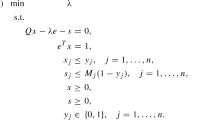Abstract
We present computational experience with a cutting plane algorithm for 0–1 quadratic programming without constraints. Our approach is based on a reduction of this problem to a max-cut problem in a graph and on a partial linear description of the cut polytope.
Similar content being viewed by others
References
E. Balas and J.B. Mazzola (1984), “Nonlinear 0–1 programming: I. Linearization techniques and II. Dominance relations and algorithms,”Mathematical Programming 30 (1984) 1–45.
F. Barahona (1986), “A solvable case of quadratic 0–1 programming,”Discrete Applied Mathematics 13 (1986) 23–26.
F. Barahona and A. Casari (1988), “On the magnetization of the ground states in two-dimensional Ising spin glasses,”Computer Physics Communications 49 (1988) 417–421.
F. Barahona, M. Grötschel, M. Jünger and G. Reinelt (1988), “An application of combinatorial optimization to statistical physics and circuit layout design,”Operations Research 36 (1988) 493–513.
F. Barahona and A.R. Mahjoub (1986), “On the cut polytope,”Mathematical Programming 36(1) (1986) 157–173.
M.W. Carter (1984), “The indefinite zero-one quadratic problem,”Discrete Applied Mathematics 7 (1984) 23–44.
M.R. Garey and D.S. Johnson (1979),Computers and Intractability: A Guide to the Theory of NP-Completeness (Freeman, San Francisco, 1979).
M. Grötschel, M. Jünger and G. Reinelt (1984), “A cutting plane algorithm for the linear ordering problem,”Operations Research 32 (1984) 1195–1220.
P.L. Hammer (1965), “Some network flow problems solved with pseudo-Boolean programming,”Operations Research 13 (1965) 388–399.
P.L. Hammer, P. Hansen and P. Simeone (1984), “Roof duality, complementation and persistence in quadratic 0–1 optimization,”Mathematical Programming 28 (1984) 121–155.
M.W. Padberg and G. Rinaldi (1986), “Optimization of a 532-city symmetric travelling salesman problem by branch and cut,”Operations Research Letters 6 (1987) 1–7.
J.C. Picard and H.D. Ratliff (1974), “Minimum cuts and related problems,”Networks 5 (1974) 357–370.
A.C. Williams (1985), “Quadratic 0–1 programming using the roof dual with computational results,” RUTCOR Research Report #8-85, The State University of New Jersey (New Brunswick, NJ, 1985).
Author information
Authors and Affiliations
Additional information
This research has been partially supported by Schwerpunktprogramm der Deutschen Forschungs-gemeinschaft “Anwendungsbezogene Optimierung und Steuerung”. Part of the work of the first author was done at the Institut für Operations Research, Universität Bonn, and it was supported by the National Sciences Research Council of Canada and the Deutsche Forschungsgemeinschaft.
Rights and permissions
About this article
Cite this article
Barahona, F., Jünger, M. & Reinelt, G. Experiments in quadratic 0–1 programming. Mathematical Programming 44, 127–137 (1989). https://doi.org/10.1007/BF01587084
Received:
Revised:
Issue Date:
DOI: https://doi.org/10.1007/BF01587084




